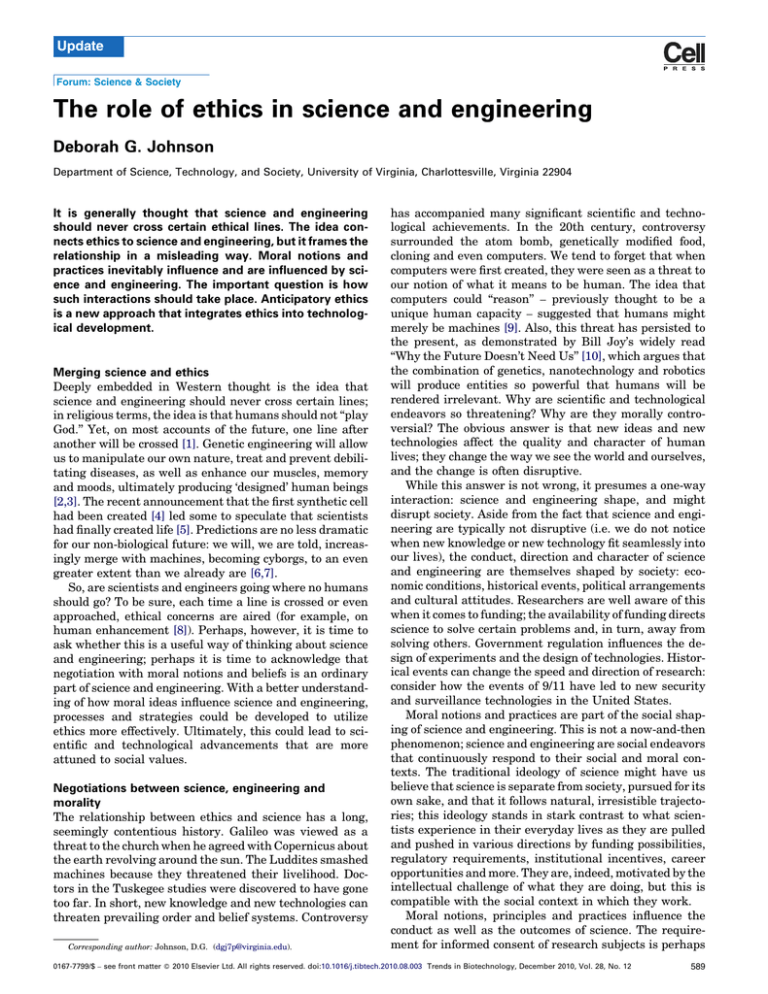The role of ethics in science and engineering Deborah G. Johnson
advertisement

Update Forum: Science & Society The role of ethics in science and engineering Deborah G. Johnson Department of Science, Technology, and Society, University of Virginia, Charlottesville, Virginia 22904 It is generally thought that science and engineering should never cross certain ethical lines. The idea connects ethics to science and engineering, but it frames the relationship in a misleading way. Moral notions and practices inevitably influence and are influenced by science and engineering. The important question is how such interactions should take place. Anticipatory ethics is a new approach that integrates ethics into technological development. Merging science and ethics Deeply embedded in Western thought is the idea that science and engineering should never cross certain lines; in religious terms, the idea is that humans should not ‘‘play God.’’ Yet, on most accounts of the future, one line after another will be crossed [1]. Genetic engineering will allow us to manipulate our own nature, treat and prevent debilitating diseases, as well as enhance our muscles, memory and moods, ultimately producing ‘designed’ human beings [2,3]. The recent announcement that the first synthetic cell had been created [4] led some to speculate that scientists had finally created life [5]. Predictions are no less dramatic for our non-biological future: we will, we are told, increasingly merge with machines, becoming cyborgs, to an even greater extent than we already are [6,7]. So, are scientists and engineers going where no humans should go? To be sure, each time a line is crossed or even approached, ethical concerns are aired (for example, on human enhancement [8]). Perhaps, however, it is time to ask whether this is a useful way of thinking about science and engineering; perhaps it is time to acknowledge that negotiation with moral notions and beliefs is an ordinary part of science and engineering. With a better understanding of how moral ideas influence science and engineering, processes and strategies could be developed to utilize ethics more effectively. Ultimately, this could lead to scientific and technological advancements that are more attuned to social values. Negotiations between science, engineering and morality The relationship between ethics and science has a long, seemingly contentious history. Galileo was viewed as a threat to the church when he agreed with Copernicus about the earth revolving around the sun. The Luddites smashed machines because they threatened their livelihood. Doctors in the Tuskegee studies were discovered to have gone too far. In short, new knowledge and new technologies can threaten prevailing order and belief systems. Controversy Corresponding author: Johnson, D.G. (dgj7p@virginia.edu). has accompanied many significant scientific and technological achievements. In the 20th century, controversy surrounded the atom bomb, genetically modified food, cloning and even computers. We tend to forget that when computers were first created, they were seen as a threat to our notion of what it means to be human. The idea that computers could ‘‘reason’’ – previously thought to be a unique human capacity – suggested that humans might merely be machines [9]. Also, this threat has persisted to the present, as demonstrated by Bill Joy’s widely read ‘‘Why the Future Doesn’t Need Us’’ [10], which argues that the combination of genetics, nanotechnology and robotics will produce entities so powerful that humans will be rendered irrelevant. Why are scientific and technological endeavors so threatening? Why are they morally controversial? The obvious answer is that new ideas and new technologies affect the quality and character of human lives; they change the way we see the world and ourselves, and the change is often disruptive. While this answer is not wrong, it presumes a one-way interaction: science and engineering shape, and might disrupt society. Aside from the fact that science and engineering are typically not disruptive (i.e. we do not notice when new knowledge or new technology fit seamlessly into our lives), the conduct, direction and character of science and engineering are themselves shaped by society: economic conditions, historical events, political arrangements and cultural attitudes. Researchers are well aware of this when it comes to funding; the availability of funding directs science to solve certain problems and, in turn, away from solving others. Government regulation influences the design of experiments and the design of technologies. Historical events can change the speed and direction of research: consider how the events of 9/11 have led to new security and surveillance technologies in the United States. Moral notions and practices are part of the social shaping of science and engineering. This is not a now-and-then phenomenon; science and engineering are social endeavors that continuously respond to their social and moral contexts. The traditional ideology of science might have us believe that science is separate from society, pursued for its own sake, and that it follows natural, irresistible trajectories; this ideology stands in stark contrast to what scientists experience in their everyday lives as they are pulled and pushed in various directions by funding possibilities, regulatory requirements, institutional incentives, career opportunities and more. They are, indeed, motivated by the intellectual challenge of what they are doing, but this is compatible with the social context in which they work. Moral notions, principles and practices influence the conduct as well as the outcomes of science. The requirement for informed consent of research subjects is perhaps 0167-7799/$ – see front matter ß 2010 Elsevier Ltd. All rights reserved. doi:10.1016/j.tibtech.2010.08.003 Trends in Biotechnology, December 2010, Vol. 28, No. 12 589 Update the best example of a moral principle that shapes the conduct of research. Conversely, science and engineering have powerful effects on morality; computers have challenged ideas about what it means to be human; reproductive technologies have made parenthood seem like a form of consumption; software has changed the rights associated with property; and pharmaceuticals have solidified ideas about what it means to be normal. Science and engineering are continuously negotiating with moral ideas. Sometimes the negotiation takes little effort and is hardly noticed because the results of science and engineering are aligned with moral values (e.g. biomedical technologies that prevent disease and extend life). Sometimes the negotiation involves issues of fairness, such as when risks and benefits must be distributed; for example, when a vaccine will save many lives, although a small number will be harmed, or when the toxic waste from production in industrialized countries are disposed of in the developing world. Other times, the negotiation is so problematic that a direction of promising research or new technology is diverted or stopped, as in the cases of embryonic stem cell research and nuclear power. It is one thing to say that science and engineering negotiate with moral notions, but another to ask how such negotiations should take place. Is there an ideal way? Although there is no easy answer here, the first step is to acknowledge that such negotiations are part of science, engineering and emerging technology. A recent breakthrough suggests that we are on the right path to figuring out how ethics could have a more productive role in science and engineering. In 2003, the 21st Century Nanotechnology Research and Development Act (Public Law 108-193) was passed. The law specifies that the National Nanotechnology Infrastructure (NNI) include activities that ensure that ‘‘ethical, legal, environmental, and other appropriate societal concerns. . .are considered during the development of nanotechnology.’’ Implicitly acknowledging that science is not just an isolated activity to be left to scientists, the law recognizes that ethical considerations are best addressed early on in the development of new technologies. It might be too early to say whether this initiative has been enormously successful, but there is a growing literature on the social and ethical implications of nanotechnology, including a journal, Nanoethics, and a yearbook [11] that are intended to consolidate ‘‘the emerging scholarship on nanotechnology in society’’ and ‘‘provide an overview of research and other activities in the field’’. The NNI initiative followed and improved upon the model set by ELSI, the unit of the Human Genome Project that was devoted to studying the ethical, legal and social issues surrounding the availability of genetic information. ELSI did not explicitly emphasize the idea that these studies would influence the design of genetic technologies, although one could argue that this intention was implicit. Both NNI and ELSI have drawn the attention of ethicists, and a new approach is beginning to take shape: an endeavor that might be called ‘anticipatory ethics’ [12]. Anticipatory 590 Trends in Biotechnology Vol.28 No.12 ethics is ethical analysis aimed at influencing the development of new technologies. Advocates argue for ethics to accompany technological development rather than just reacting to it [13]. The endeavor is a daunting challenge because new technologies and moral notions are both moving targets. A developing technology is ‘in the making’; it is not yet a fixed or clearly delineated thing that can be studied in use. Ethical concepts are also fluid. Some fundamental ethical concepts and principles have endured for thousands of years, but they often have variable interpretations; their application to new situations can be uncertain and controversial; and their meaning can change in subtle ways over time. Although a challenge, anticipatory ethics is the best opportunity for ethical perspectives to influence science and technology. Directing rather than interfering What are we to make of the rhetoric of ‘going where no humans should go’? The above analysis suggests why the questions raised are so important and why the rhetoric is misleading. We should be asking whether science and engineering are taking us where we want to go; bringing morality into engagement with science and engineering ensures that human ends and values are served. However, the rhetoric of line-crossing and restricting is misleading because it suggests that science and engineering are endeavors that move independently of society, and, now and then, must be interfered with, restricted or diverted. This blinds us from seeing science as a means to social ends and it deflects attention away from issues about how science and engineering are now being directed. Acknowledgment that science and engineering continuously interact with moral notions and practices opens the way to developing more effective ways to include ethics in steering science and engineering research. References 1 2 3 4 5 6 7 8 9 10 11 12 13 Friedman, D. (2008) Future Imperfect, Cambridge University Press Green, R. (2007) Babies by Design, Yale University Press Bess, M. (2008) Icarus 2.0. Technology and Culture 49 (1), 114–126 Gibson, D.G. et al. (2010) Creation of a bacterial cell controlled by a chemically synthesized genome. Science 329 (5987), 52–56 Callaway, E. Immaculate creation: birth of the first synthetic cell. New Scientist 17:55 20 May 2010 (www.newscientist.com/article/dn18942immaculate-creation-birth-of-the-first-synthetic-cell.html) Clark, A. (2003) Natural-born Cyborgs: Minds, Technologies, and the Future of Human Intelligence, Oxford University Press Kurzweil, R. (2005). The Singularity is Near: When Humans Transcend Biology (1st edn), Viking Adult Savulescu, J. and Bostrom, N. (2009) Human Enhancement, Oxford University Press Weizenbaum, J. (1976) Computer Power and Human Reason, W.H. Freeman and Company Joy, B. (2000) Why the future doesn’t need us. Wired 8 (4), 238–262 Fisher, E. et al. (2008) The Yearbook of Nanotechnology in Society (Vol. 1), Presenting Futures, Springer Johnson, D. (forthcoming). Software agents, anticipatory ethics, and accountability. In The Growing Gap Between Emerging Technologies and Legal–Ethical Oversight. The Pacing Problem (Marchant, G. E. et. al., eds), Springer Verbeek, P. (2010) Accompanying technology: philosophy of technology after the ethical turn. Techne’ 14 (1), 49–54





